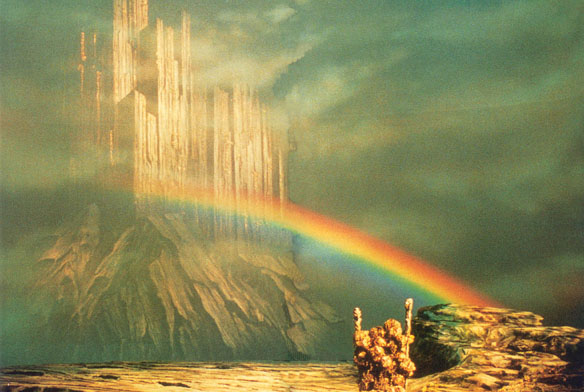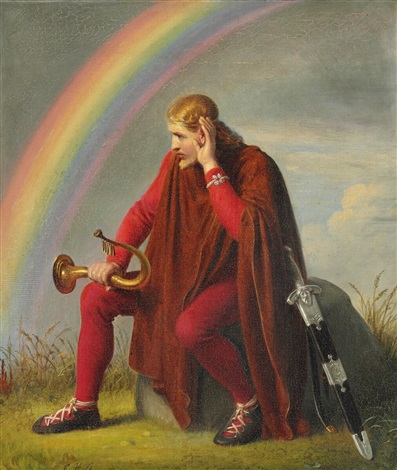The Bifrost, or rainbow, is a bridge connecting Midgard, the Earth, with Asgard, the home of the gods. Only the gods were permitted to cross this bridge, which was guarded by the god Heimdall. The Milky Way has also been associated with this bridge.
Read on to learn more about this sacred bridge for the Norse gods.
What is the Bifrost?
Norse mythology describes Bifrost or Bilröst as a burning rainbow bridge connecting Midgard (Earth) and Asgard, the realm of the gods.
It is attested as Bilröst in the Poetic Edda, which was compiled from earlier traditional sources in the 13th century, and as Bifröst in the Prose Edda, which Snorri Sturluson wrote in the 13th century.
In both the Poetic Edda and the Prose Edda, the bridge is alternatively referred to as Ásbrú (Old Norse “Æsir’s bridge”).
What does the Bifrost bridge connect?
Bifrost is a rainbow bridge that connects the world of men on Earth (Midgard) with the realm of the Nordic gods who live in Asgard (aka Heaven).
It is described as the main route through which the Earth is connected to Asgard in the collected stories about Nordic mythology, used to transport not only gods but also souls of men who have proven themselves worthy warriors during their lives to accompany Odin and other Nordic gods in the final “end times” battle during the mythical event of Ragnarök.
In the records of literary history, specifically in the compilations of the thirteenth-century poems and earlier records Poetic Edda and Prose Edda, the bridge has been described as a fleeting and unstable rainbow that touches Earth from Heaven, guarded at Asgard’s side by the ever-vigilant god Heimdall.
All verses and stories about Nordic mythology describe the Bifrost as “fleeting” and “trembling,” giving meaning to every sighting of rainbows and indicating that behind every rainbow lies the path to the otherworldly Asgard.

Who guards the Bifrost Bridge and why?
Heimdall (aka Heimdallr, Heimdali, Heimdal, Rig, Hallinskiði, Gullintanni, and Vindhlér or Vindlér) is the Nordic god tasked with the protection of the Bifrost bridge against the arrival of giants.
Asgard and Earth are predicted to be destroyed by these giants during Ragnarök’s apocalyptic events.
In the Norse pantheon, Heimdall is one of the most important gods. In addition to possessing the power of foreknowledge and extraordinary vision and hearing, he was instructed to protect the Bifrost from his fortress, Himinbjörg, which was situated where the shimmering rainbow bridge connected the land of Asgard to the land of the Bifrost.
By the prophecies known to the Æsir gods, Heimdall was to be the first of the gods to see signs of Ragnarök and was predestined to die in battle while killing Loki.
Heimdall
His appearance was one of majestic beauty and light. Among his weaponry and armor were a flashing sword, the horn Gjallarhorn (which he used to warn the Asgard gods of impending danger), the golden-maned horse Gulltoppr, and the white armor that shone brightly.
Several stories depict him as a personification of or closely associated with Yggdrasil, the World Tree.
According to some legends, he was a son of Odin and had nine mothers, who were depicted in Norse myths as sisters and personifications of sea waves.
The Earth’s power, the moisture of the sea, and the heat of the sun enhanced him as a baby. As a result, he gained the power of foreknowledge, acute hearing, and excellent vision. It is even believed that he required less sleep than a bird to be a better guardian of Asgard.
In surviving stories and poems, Heimdall is also called by three different names – Hallinskiði, Gullintanni (“the one with the golden teeth”), and Vindhlér or Vindlér (“the one protecting against the wind/sea.”

Why is it called the Bifrost Bridge?
The original name was likely “Bilröst,” which can be loosely translated as “the fleetingly glimpsed rainbow.” The modern translation is “the shaking or trembling rainbow.”
Other translations have been offered by modern scholars as well. According to Andy Orchard, a British academic in Old English, Norse, and Celtic literature, the best translation of Bifrost is “shimmering path”; however, the element “bil” (“a moment”) paints the bridge with the “fleeting nature” of the rainbow.
Similarly, the Old Norse word “bifa” (“to shimmer” or “to shake”) is closely related to the etymology of the word Bifrost.
In addition, Austrian Germanist Rudolf Simek suggests that Bifrost is best translated as “the swaying road to heaven.”
The role of the Bifrost during Ragnarök
Bifrost bridge is closely associated with the myth of Ragnarök, which describes a series of future events, battles, the destruction of the world, and the predetermined death of many major Nordic deities.
The beginning of Ragnarök will be marked by two specific events – the disappearance of the sun and moon and the sounding of the horn alarm by Heimdall, who guards the rainbow bridge.
In response, Odin and most of the other Æsir and Vanir gods, Valkyries, and spirits of brave men who lived in Asgard ride the Bifrost bridge to Earth, where the final battle will be fought.
Most gods will die in the battle; giants will storm across the Bifrost’s rainbow bridge, raising and destroying Asgard. Once the Earth has been burned and submerged, it will eventually rise from the depths of the sea, reborn anew.
The Bifrost interpretation and theories
- Professor emeritus John Lindow, an expert in Scandinavian medieval studies and folklore, has suggested a connection between Bifrost and bridge Gjallarbr. The former connects the land of the living with the realm of the gods, whereas the latter joins the land of the living with the underworld (or the world of the dead).
- Some believe that the Bifrost should not be represented as a rainbow but rather as the Milky Way at night.
- Thor was described as needing to walk during the last days of Ragnarök in Prose Edda’s Gylfaginning book. According to some interpretations, Thor’s walking represents the end of the rainbow after the rain.
The Bifrost in Marvel
In the Marvel Cinematic Universe, the rainbow bridge Bifrost is an interstellar portal powered by advanced technology that connects the realm of Asgard with eight different worlds, including Earth (Midgard), Jotunheim (the frozen planet of Giants), and Svartalfheim (the home of the Dark Elves), among others.
It is depicted as a crystal decking structure that reflects light in a rainbow-like pattern. The portal to the other worlds can be activated with either Heimdall’s sword or Odin’s spear Gungnir.
Leaving the portal open for a prolonged period of time can even destroy the target destination (even entire planets) that it carries passengers to. It is the portal beam itself that is referred to as Bifrost and not the bridge-like structure found in Asgard.
All standalone Thor movies, several Avengers films, and the TV series Agents of S.H.I.E.L.D. feature the Bifrost.

